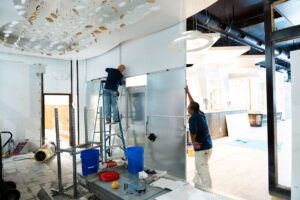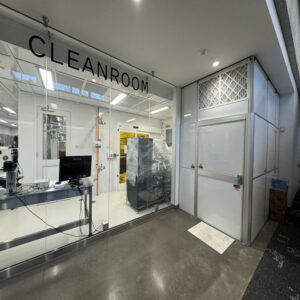A Complete Guide to ASTM Class A Fire Rating
The American Society of Testing and Materials (ASTM) conducts E-84 testing to gauge a specific material’s flame spread and smoke development properties. Temporary Wall Systems (TWS) has achieved the highest rating possible, What is a Class A fire rating?
TWS containment solutions meet International Building Code (IBC) Class A and National Fire Protection Agency (NFPA) Class A standards. Today, we’re answering common questions about how these ratings are acquired and why they’re important.
What is IBC Class A?
The IBC categorizes structures based on their level of fire resistance. A Type I construction is Class A-rated.
A Class A Type I structure features exterior materials that are fire-resistant for three hours, interior beams resistant for two hours, and interior floors and ceilings resistant for an hour. This top rating is the standard for taller buildings, like high-rises or apartments.
Here is the complete list of IBC construction classes:
| Class A-Type I | Fire resistant rating of three hours or more, classed as “fire resistive” |
| Class B-Type II | Fire resistant rating of two hours, classed as “non-combustible” |
| Class C-Type III | Fire-resistant rating of at least one hour, classed as “ordinary construction” |
| Class D-Type IV | Classed as “heavy timber construction,” elements of these buildings, such as the frame, will withstand an hour of fire |
| Class E-Type V | Classed as “wood frame construction,” this is considered an unprotected combustible construction. |
How is an IBC Class A rating different from ASTM Class A?
ASTM E-84 testing certifies how fire-resistant a material is. IBC classification considers the fire resistance of the whole structure.
With ASTM and IBC Class A ratings, TWS wall systems fit seamlessly in structures that require or desire the highest levels of total fire resistance.
What is NFPA Class A?
As a national authority on fire safety, the NFPA offers various ratings and classes for fires and flammables. The Class A rating is given to building materials with the lowest flame spread and meet the smoke development standard. They use specialized indexes to determine this:
| Flame Spread Index | Smoke Development Index | |
| Class A | 0-25 | 450 max |
| Class B | 26-75 | 450 max |
| Class C | 76-200 | 450 max |
The smoke development index ranges from 0 to 1,000. No building material, regardless of class, can exceed 450 to achieve an NFPA rating.
How do you get an NFPA Class A rating?
To get the NFPA Class A rating, a material must:
- Meet the 25 or less flame spread requirement
- Have a max smoke development score of 450
- Undergo testing that meets the NFPA 286 Standard
- Be certified by a reputable organization such as the ASTM or UL
From there, NFPA Class A materials must be labeled as such and regularly inspected to ensure that manufacturing continues to meet Class A standards.
How is ASTM E-84 testing performed?
The E-84 fire rating test is conducted with a 24” x 24’ sample of the testing material, a Steiner tunnel, and two burners providing roughly 89 kW of energy.
What is a Steiner tunnel?
A Steiner tunnel is a large, oblong enclosure lined with fire brick. It was developed in the 1940s and became the ASTM testing standard in 1950.
Here’s a brief overview of the testing process:
Pre-testing
The material sample undergoing testing has to be conditioned to equilibrium moisture content (EMC), which is the stage at which the sample does not lose or gain moisture. The environment is set at 73.4 ± 5°F and 50 ± 5% relative humidity to achieve this.
Preheating
Meanwhile, the Steiner tunnel is preheated to 150°Fahrenheit and then cooled to approximately 105°F.
Setting up the test
The material sample is weighed to confirm EMC and positioned on a ceiling under a lid.
Conducting the test
After closing the chamber and establishing airflow, the sample is preheated for roughly two minutes. Next, a dual-point methane gas burner facing up at the exposed surface of the sample ignites.
Monitoring and recording
An observer watches the 10-minute burn test from a port at one side of the tunnel, monitoring the flames’ advancement. A photometer system and a thermocouple probe measure smoke density and record temperature data.
Producing results
The data gathered during the test indicates where the sample scores. Data shared in the final report includes but is not limited to:
- Flame spread index
- Smoke development index
- Time taken to ignite
- Time to maximum temperature
- Temperature vs. time
- Smoke area vs. time
- Flame spread distance vs. time
Is the ASTM E84 certification required?
No, E-84 certification is not required for temporary wall systems like ours. However, the IBC and NFPA require it for permanent interior wall and ceiling finishes. NFPA guidelines also dictate that buildings without a fully operational sprinkler system should use fire-rated temporary walls.
TWS finds it important to offer temporary walls that are ASTM E84-certified for two reasons:
- It offers a degree of fire resistance consistent with materials already present in your building. Supporting and enhancing existing levels of safety – not subtracting from them – is a priority.
- Certifications such as the E84 assist with quality assurance. A certified product is more likely to be consistently manufactured to the standard identified during testing.
What is the Canadian equivalent of ASTM E84?
The Canadian equivalent of ASTM E84 is CAN/ULC-‐S102.2. The Canadian test method also utilizes a Steiner tunnel, but some materials may be mounted in a different position, such as on the apparatus’s floor.
What’s the difference between ASTM E84, UL 723, NFPA 255, and UBC 8-1?
They are the same. ASTM, UL, NFPA, and UBC all use the same procedure and standard to measure a material’s surface burning characteristics.
What happens if you fail the ASTM E84 test?
The E-84 is not a pass/fail test. It’s a tool for measuring how materials react when exposed to flame.
However, suppose a material or product used in construction – such as paint or insulation – fails to meet a standard dictated by codes and regulations. In that case, it may not be used. Companies often opt to revise and resubmit the product for testing.
What about ASTM E-119?
ASTM E-119 testing measures a material’s structural integrity after fire exposure. The ASTM E-84 measures flame spread and smoke development.
How do you improve fire resistance?
Consult local fire prevention codes and requirements and those specific to your industry.
Then, sustain your adherence to safe practices by choosing TWS. Our ASTM, IBC, and NFPA Class A containment solutions are approved for all construction types, from healthcare and laboratories to retail spots and universities.
Our turnkey service means you’ll never have to worry about storage, maintenance, or installation. Request your estimate today.


